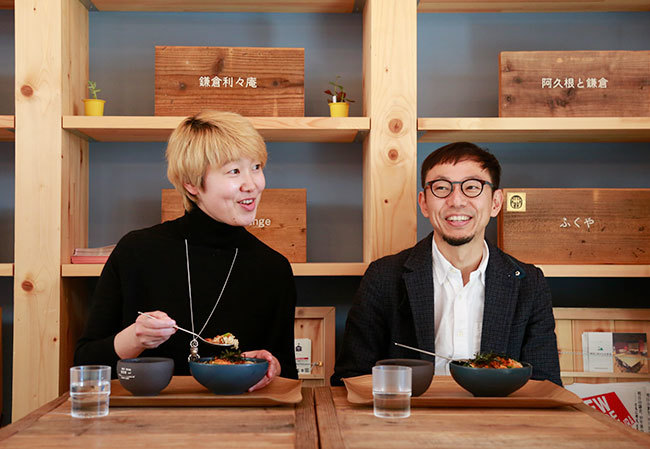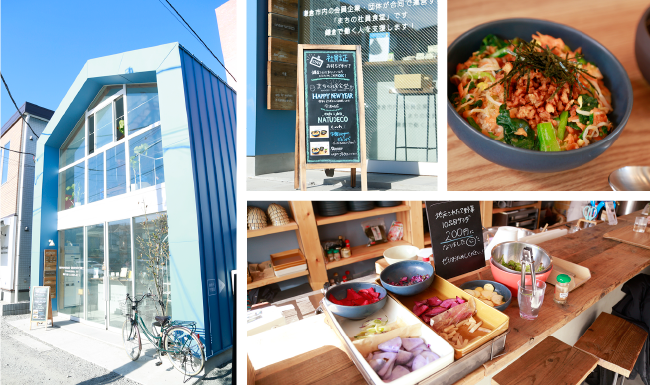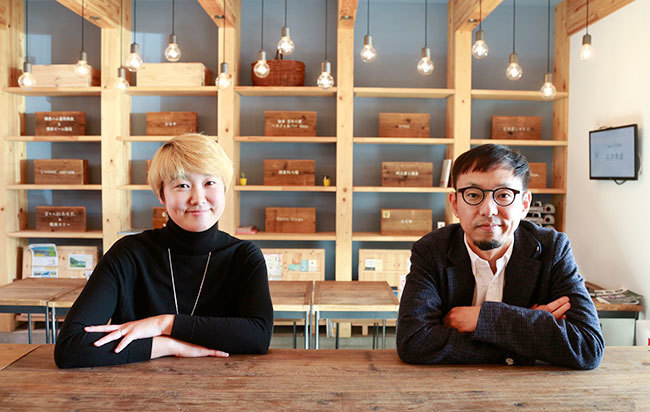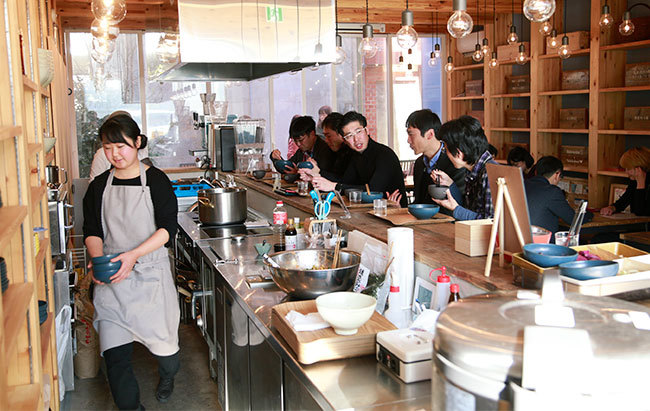This project features reports from Dentsu Inc. communication planners active on the front lines, sharing "currently intriguing scenes and spots" that have caught their attention.

(From left) Yuko Yoshiba, Daisuke Yanagisawa (Kayac Inc.)
Using the power of "interesting,"
Creating Regional Communities Beyond Corporate Boundaries
Planner Yuko Yoshiba visited the "Town Employee Cafeteria" in Kamakura City, Kanagawa Prefecture. This "employee cafeteria," accessible to anyone working in Kamakura, was realized through the collaboration of 30 companies and organizations based in Kamakura. Forty Kamakura restaurants take turns weekly, providing healthy and delicious menus. It is operated by Kayac Inc., a creative company headquartered in Kamakura.
Recently, many companies transform their cafeterias into unique spaces as part of their branding efforts. Amidst this trend, three points particularly caught Yoshiha's attention:
❶ Why did they choose to create a shared cafeteria involving various players, rather than limiting it to their own company?
❷ What challenges, if any, were encountered in making this a reality?
❸ Beyond the "fun factor" that Kayac values, what other criteria guide their business development?
Interview with Daisuke Yanagisawa, President of Kayac Inc.
【Q1】
We found the concept of a "shared employee cafeteria involving the local community" to be interesting. What was the background for this idea?
The trigger was the completion of our new office building in November 2018, which meant Kayac employees previously based in Yokohama would all gather in Kamakura. Kamakura has many tourist-oriented restaurants, but few affordable, everyday eateries for working people. So we decided to create our own cafeteria.
But we wanted to make it interesting, so instead of a traditional "closed employee cafeteria," we decided to create an "open employee cafeteria." We wanted to build a place where people in the town could connect, which led us to the concept of a cafeteria for everyone working in Kamakura.
We designed features to encourage interaction between strangers, like a rule where visitors place their business cards in a case and wear them around their neck. What was fascinating was seeing employees from diverse fields—city hall, the tourism association, startups, long-established companies, securities firms—gather and form a new community. It felt like a uniquely Kamakura scene.
We were also surprised by how supportive local restaurants were, far more than expected. Everyone participates in running the space with the mindset, "If it's for people working in Kamakura."
As a creative IT company, Kayac is experienced in website development and community management using SNS. But I believe the main reason so many people participate is simply because it's fun. Since starting the company 20 years ago, I've believed that "fun" is what motivates people.
While we have left-brain strategies, we also value the right-brain criterion of whether something is fun. I feel this is the secret to creating things that resonate with people. (Yoshiha)
【Q2】
Why the strong focus on Kamakura, which isn't your hometown?
What other initiatives are you involved in?
Simply put, "because I love Kamakura." But perhaps it's also possible because I'm the kind of person who doesn't fixate on my hometown when taking on a cause. Also, Kamakura is a welcoming town for newcomers. With over 1000 years of history, there seems to be an atmosphere where a few decades' difference in how long you've lived here doesn't really matter.
To further revitalize Kamakura, Kayac runs the "Town's XX" series alongside the "Town's Employee Cafeteria." For example, "Town's Nursery Kamakura" addresses the childcare waitlist problem our own employees faced. This nursery prioritizes Kamakura workers, with its second floor as a shared office—allowing parents to work while their children are cared for and fostering new communities.
Other initiatives include "Town HR," which holds joint job fairs and training sessions for local companies to tackle Kamakura's population issues, and "Town Cinema," which transforms cafes and restaurants into movie theaters to address the lack of a dedicated cinema. These projects approach Kamakura from various angles, aiming to make it a more comfortable and interesting place to live.
The appeal lies in its flexibility, free from rigid notions of "how things must be." This might be the key to building a great company and a great community. (Yoshiha)
【Q3】
I heard you're trying to realize "Kamakura Capitalism."
What exactly are you trying to do?
First, "Kamakura Capitalism" is one form of "Regional Capitalism." Regional Capitalism is the idea that a community's happiness comes from increasing its "regional capital" – not just financial resources, but also human connections, nature, and culture – in a balanced way. In a world where GDP figures measuring economic growth no longer directly correlate with national happiness, the hypothesis is that creating a yardstick to measure the richness of this "regional capital" and working together, public and private sectors united, to enhance it will foster people's happiness. We are trying to prove this hypothesis, starting with the land of Kamakura.
As a first step, Kayac is currently advancing plans to issue a unique local currency for Kamakura. When this "Kamakura Capitalism," an updated form of traditional capitalism, becomes more established, the people living and working in this region will enjoy more interesting daily lives. We firmly believe this can be achieved, as we now live in an era where everyone seeks "interesting experiences" more than money.
"Wash Dishes for Lunch for 10 Yen!" Voucher
The ticket machine currently sells "Wash Dishes for 10 Yen Lunch!" tickets (limited to 2 people per day). Beyond the bold discount rate, the appeal lies in communicating with other customers through work. "Fun" mechanisms are sprinkled throughout.
Finally... (by Yoshiwa)
I sensed an openness and depth in both the concept of the "Community Employee Cafeteria" and President Yanagisawa's philosophy. In today's era, where rules can often feel restrictive, this flexibility is incredibly valuable. Visiting in person, I was also struck by the meticulous attention to execution. The thoughtful details designed to connect people were evident everywhere. As a communication planner involved in everything from strategy to output, I found numerous points to learn across various layers.
















